Desmodus stocki
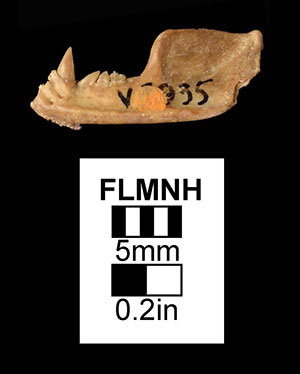
Quick Facts
Common Name: Stock’s vampire bat
With a range extending to Virginia, this species lived further north than any other vampire bat, fossil or living.
Desmodus stocki likely weighed about 50% more than the living vampire Desmodus rotundus.
Its large, sharp canines and greatly reduced, practically functionless molars show that Desmodus stocki had a diet limited to blood.
Age Range
- late Pleistocene to Holocene Epochs; Rancholabrean land mammal age
- About 120,000 years ago to 5,000 years ago (Grady et al., 2002)
Scientific Name and Classification
Desmodus stocki Jones, 1958
Source of Species Name: This species is named for Professor Chester Stock, a paleontologist at the California Institute of Technology who directed the collection of fossils from San Josecito Cave, Nuevo León, Mexico, where the holotype of this species was found.
Classification: Mammalia, Eutheria, Laurasiatheria, Chiroptera, Yangochiroptera, Noctilionoidea, Phyllostomidae, Desmodontinae
Alternate Scientific Names: Desmodus magnus
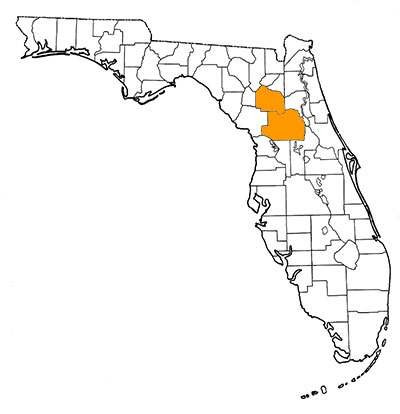
Overall Geographic Range
Desmodus stocki ranged from northern Mexico into the southwestern and southeastern United States. Specifically, fossils have been recovered as far south as the Valley of Mexico and as far north as Virginia, in addition to California, Arizona, New Mexico, Texas, and Florida (Martin, 1972; Harris, 1987; Morgan et al., 1988; Grady et al., 2002; Czaplewski and Peachey, 2003). The type locality of this species is the San Josecito Cave in Nuevo León, Mexico (Jones, 1958).
Florida Fossil Occurrences
Florida fossil sites with Desmodus stocki:
- Alachua County—Arredondo 2A
- Marion County—Reddick 1A; Reddick 1B; Reddick 1C
Discussion
Chiroptera is the order which consists of bats, the only mammals capable of powered flight. Phyllostomidae is a family within Chiroptera that includes bats restricted to the New World that are primarily found in tropical North America (Morgan, 1991). Desmodontinae is a phyllostomid subfamily consisting of species commonly known as vampire bats. Desmodus stocki, or Stock’s Vampire Bat, is an extinct relative of the extant common vampire bat, Desmodus rotundus. Vampire bats are commonly called so because they feed exclusively on the blood of mammals by piercing through their skin using highly specialized teeth (Kurtén and Anderson, 1985). While extant vampire bats are restricted to warmer climates due to their intolerance for the cold and do not currently occur in temperate North America, Desmodus stocki is one of several species of vampire bats that existed to the north of their current range in the Pleistocene and Holocene epochs. Other such species include the oldest known vampire bat Desmodus archaeodaptes from the Irvingtonian North American land mammal age (early Pleistocene) of Florida (Morgan et al., 1988) and Desmodus puntajudensis from the Holocene of Cuba (Suárez, 2005).
Because the earliest record of phylostomatid bats occur in the Miocene of South America and the earliest known vampire bat, Desmodus archaeodaptes, occurs in the early Pleistocene of North America after the formation of a land bridge between North and South America, it is thought that vampire bats originated in South America and migrated to North America during an event known as the Great American Biotic Interchange (GABI; Morgan, 1988; Morgan, 1991). During the Great American Biotic Interchange, animals from South America migrated to North America and vice versa when the Isthmus of Panama formed between the two continents approximately 2.5 million years ago. It is thought that Desmodus evolved in South America and followed their preferred food source, possibly ground sloths, into North America as they dispersed northward (Morgan, 1991). Indeed, fossils of ground sloths are a common occurrence with Desmodus stocki in the Florida fossil localities known from Reddick cave (Olsen, 1960).
In Florida, Desmodus stocki was first known as Desmodus magnus. Jones (1958) submitted a manuscript describing and naming Desmodus stocki based on specimens found in San Josecito Cave, Mexico, only 11 days before Gut (1959) submitted a manuscript describing and naming Desmodus magnus based on specimens from the Reddick fossil localities in Florida. Evidently, the two authors did not know of each other’s work (Hutchinson, 1967). While Olsen (1960) believed the two species were distinct, Desmodus magnus was eventually synonymized with Desmodus stocki by Hutchinson (1967) based on qualitative similarities between the cranial anatomy and size of the two species. Morgan (1991) quantified and compared measurements from specimens from both species and also found no significant difference. Thus, Desmodus magnus is currently considered to be the same species as Desmodus stocki and the former name is treated as a junior synonym.
Fossils of Desmodus stocki have been recovered from Mexico and several states in the southwestern and southeastern United States. They are known from cave deposits and are presumed to have roosted in caves. Recovery of their fossils as far north as Virginia has been used to suggest that Desmodus stocki was perhaps more tolerant of colder temperatures than the extant Desmodus rotundus. However, Grady et al. (2002) suggested that it was more likely that Desmodus stocki was about as cold-tolerant as Desmodus rotundus based on the association of their fossils with cold-intolerant reptiles and amphibians in Virginian sites, and concluded that some intervals of the late Pleistocene were warmer than today. Both Gut (1959) and Hutchinson (1967) reported specimens of Desmodus stocki from the Haile limestone quarries of western Alachua County, Florida. However, these specimens were never cataloged and are not present in the collections of the Florida Museum of Natural History. Until specimens are deposited into a museum collection, these records have no scientific standing.
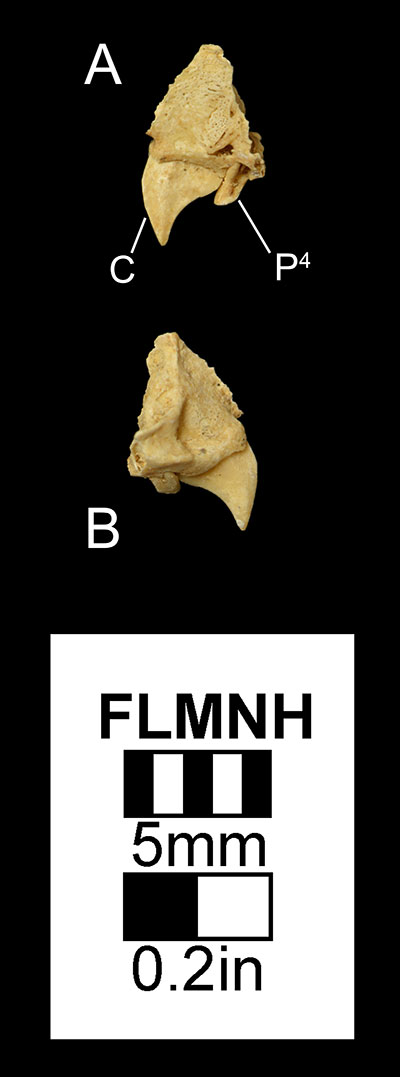
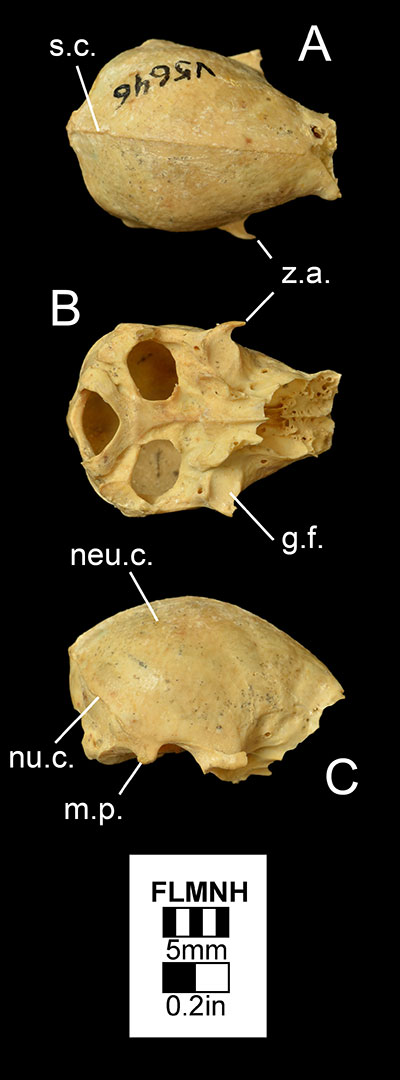
Like other vampire bats of the genus Desmodus, Stock’s vampire bat is characterized by a uniquely shaped upper incisor that is not shared by any other mammal group (Czaplewski and Peachey, 2003). The upper incisors and canines (Fig. 2) are relatively large and flat like a blade, and the posterior dentition is diminutive and evidently non-functional (Kurtén and Anderson, 1985; Czaplewski and Peachey, 1987). The specialized upper anterior dentition of Desmodus is an adaptation for obtaining their exclusively sanguinovorous (blood-eating) diet. These teeth are used to slice into the skin of their prey so that the bats may lap up the blood with their tongues. In addition, like other members of the genus Desmodus, Desmodus stocki has a short rostrum and an arched skull shape (Kurtén and Anderson, 1985). These features combined make the skull of Desmodus rather diagnostic.
The skeleton of Desmodus stocki is very similar to that of the extant common vampire bat, Desmodus rotundus and suggests that the two species are likely fairly closely related. However, there is a significant difference in size and proportions of body parts between the two species. Compared to the extant common vampire bat, Desmodus stocki is generally more robust and is 15-20% larger in size. It has also been found that the two species’ cranial measurements do not overlap in size (Morgan, 1991). The sagittal, nuchal, and temporal crests are relatively better defined, as are the mastoid process and cranial foramina (Olsen, 1960; Morgan, 1991). The rostrum and the palate are wider and the neurocranium (braincase; Fig. 3) is more globular, but the region between the orbits is narrower in Desmodus stocki relative to Desmodus rotundus (Jones, 1958; Morgan, 1991). The cheek teeth of the extinct vampire bat are larger and relatively more robust compared to those of the extant vampire bat (Jones, 1958; Gut, 1959). However, the zygomatic arches of Desmodus stocki are more gracile than those of Desmodus rotundus (Morgan, 1991). The area of the articular surface of the glenoid fossa of Desmodus stocki is relatively larger compared to that of Desmodus rotundus, suggesting that Stock’s vampire was capable of a wider, more mobile gape than the common vampire bat (Olsen, 1960). The upper incisors were also more procumbent, or protruding, in the extinct species than the extant, although the mandibles (Figure 4) were more similar in morphology except for the larger size of Desmodus stocki (Morgan, 1991).

Desmodus stocki has longer, more robust forelimbs than Desmodus rotundus; the humerus and radius (Fig. 5) are thicker and more elongate. Interestingly, the proportion of the hindlimbs (Fig. 6) of Desmodus stocki relative to the rest of the body differs in comparison to Desmodus rotundus. While the shaft of the femur is 30% thicker and the shaft of the tibia is 40% thicker in Desmodus stocki, the length of the two hind limb bones are about the same length or slightly shorter than those of the common vampire bat. The proximal and distal ends of the femur and tibia are also larger relative to the length of those bones when compared to Desmodus rotundus. This difference in hindlimb proportions suggests that Stock’s vampire bat most likely used its hindlimb to move about in a different way from the common vampire bat, probably related to the two species’ food source of choice. While it has been suggested that Desmodus stocki could simply be a larger geographic or temporal variant of Desmodus rotundus due to their similarities, these differences in relative hind limb proportions combined with non-overlapping cranial measurements suggest that they were two separate species (Morgan, 1991).
Compared to other fossil vampire bats, Desmodus stocki is intermediate in size between Desmodus archaeodaptes (which is about the same size as the extant common vampire bat) and Desmodus draculae, an extinct giant vampire bat from South America (Morgan et al., 1988; Morgan, 1991). Several details of the cranial anatomy are also diagnostically different between extinct species of Desmodus.
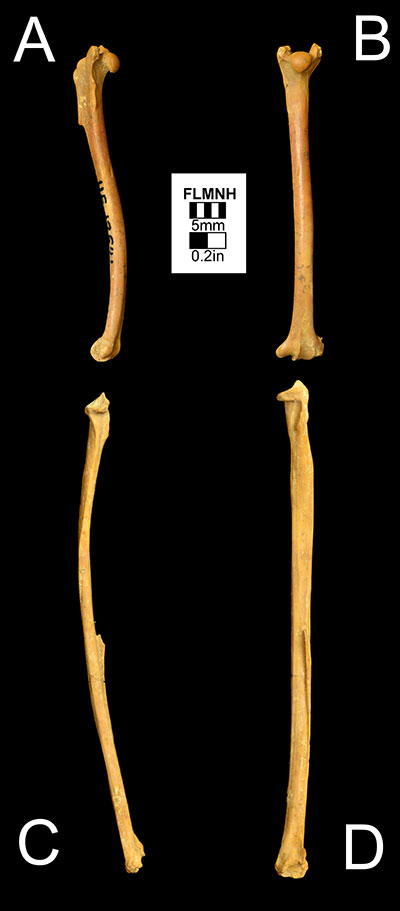
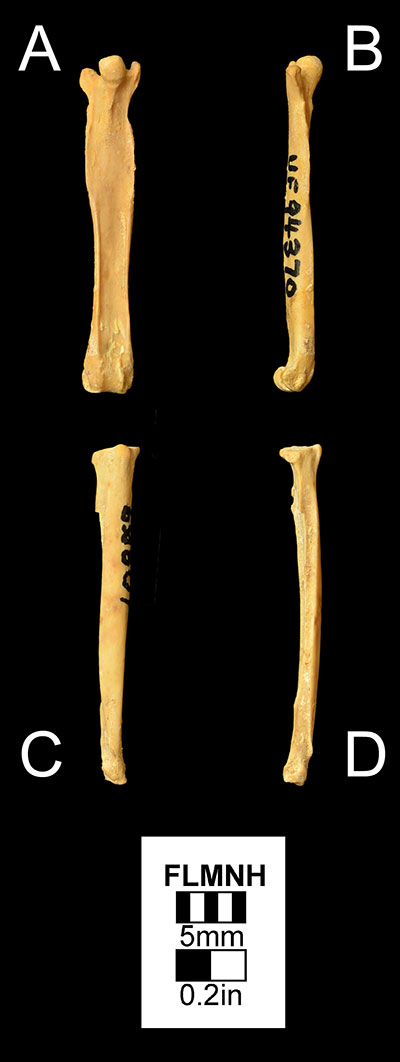
Sources
- Original Author: Arianna Harrington
- Original Completion Date: May 7, 2015
- Editor(s): Richard C. Hulbert, Jr. and Natali Valdes
- Last Updated On: May 29, 2015
This material is based upon work supported by the National Science Foundation under Grant Number CSBR 1203222, Jonathan Bloch, Principal Investigator. Any opinions, findings, and conclusions or recommendations expressed in this material are those of the author(s) and do not necessarily reflect the views of the National Science Foundation.
Copyright © Florida Museum of Natural History, University of Florida